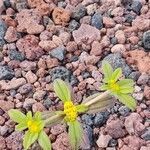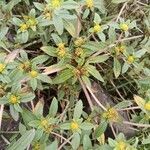Annuals, to 200+ cm (delicate or robust, glabrate or glabrous). Stems erect. Leaves petiolate (proximal, petioles 10–20 mm) or sessile (distal); blades lanceolate or oblanceolate to elliptic or subovate, 30–150 × (7–)10–40 mm, bases (distal) connate, margins serrate, serrate-dentate, or spinulose-serrate. Heads 30–300+, in tight, axillary, sessile glomerules (receptacles of glomerules setose). Calyculi 0. Involucres oblong and cylindric or angular, 3.8–4.5 mm. Phyllaries usually 2, oblong (closely investing and falling with mature cypselae). Ray florets 0–1; laminae pale yellow or whitish, oblique or suborbiculate, 0.5–1 mm. Disc florets 0–1(–2); corolla tubes 0.5–1.4 mm, throats campanulate, 0.5–0.8 mm. Cypselae oblanceoloid to subclavate, 2–2.6 mm (rays longer); pappi 0. 2n = 36.
Annual herb to 1.5 m high. Leaves sessile, linear to narrowly lanceolate, 2–11 cm long, 0.15–0.9 cm wide, entire to shortly serrate, acute, glabrous, with 3 longitudinal veins. Synflorescence axillary, comprising several capitula, each containing 1 or 2 florets. Involucral bracts 2, concave or cymbiform, 4.2–5.5 mm long, obtuse or lacerate at apex, glabrous; receptacle convex, with a few slender acuminate setae. Ray florets with ligule 0.5–0.8 mm long. Disc florets: corolla tube 1.5–2.3 mm long, with minute hairs on outer surface; lobes deltate; anthers enclosed in corolla tube, 0.9–1.2 mm long. Achenes oblanceolate, 2.6–3.3 mm long. Pappus absent.


